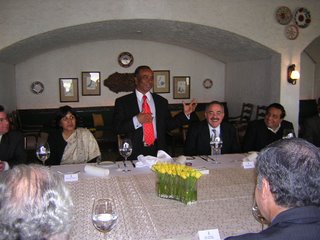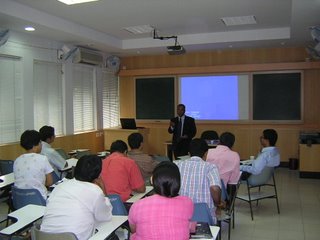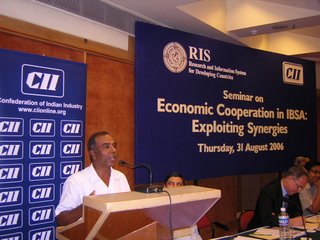Opinion - Foreign TradeDominican Republic: The business-pleasure tango
R. Viswanathan
For those Indian businessmen who raise their eyebrows at the mention of business with the Dominican Republic, here is a fact that should make them take notice. At $11 billion in 2006, the Dominican Republic is the largest importer among the 21 countries in the Central American and Caribbean region. Even a one per cent share of this $11 billion amounts to $110 million, and Indian exporters can easily exceed this target if they take this market seriously.
DR, as the Dominicans call their country, has a population of 9 million and a GDP of $30 billion. The country's macro-economic fundamentals are strong and healthy. The economy has been growing at over 8 per cent in the last two years — among the highest in the entire Latin American and Caribbean region.
The Government has put in place an investor-friendly policy framework and is keen to attract foreign investment. The economy, which was earlier dependent on sugar, coffee and tobacco exports, has now diversified with the growth of industries and tourism.
Light engineering goods and textiles exports from the free trade zones have surpassed traditional exports of primary commodities. The DR's total exports in 2006 were $6 billion. Tourism revenue accounted for $4 billion and remittances from the Dominicans settled in the US accounted for $3 billion.
Access to US market
DR offers a port of entry to the US market because of its free trade agreement (FTA) with the latter and its closeness and good connectivity. There are 13 daily flights to US cities and Miami is just 90 minutes away. DR is an associate member of SICA, the Central American Regional Economic Group, which is moving towards a Customs union. The strategic location of DR — bridging the Caribbean and Central American regions — makes it an ideal hub for doing business in the two regions.
The Government of DR has been bitten by the IT bug. It is keen to develop DR as a near-shore IT service and delivery centre. It has set up a large cyberpark complex, which offers infrastructure and world-class telecom facilities. BPOs and call-centres in English and Spanish have started operating from there.
The demography of DR is perfect for IT business, since much of the population is young with an average age of 24. Although Spanish is the official language, English is popular, thanks to the influence of the large Dominican community in the US. Dominicans have come to work in India too! There are 30 of them working in a BPO in Hyderabad.
Stable polity
What about political stability? After having gone through military dictatorship and instability, like many other Latin American countries, DR is now a stable democracy with established institutions and practices. DR is free from the crime and violence that characterise some of the countries in the region.
The Government of DR is seriously courting Indian business. The IT and Investment Minister, Mr Eddy Martinez, visited India four times in the last two years. The DR's Foreign Minister was in India in 2006 with a large business delegation. DR has had an embassy in Delhi since 2006. The embassy issues one-year multiple-entry business visas on the same day of application and is proactively promoting business between the countries.
In the last two years, many Indian companies have started entering the DR market.
A pharmaceutical delegation visited DR in 2006 and has come back with several orders and optimism. Some IT companies are exploring the possibility of setting up BPOs and delivery centres.
Looking beyond business
Besides business opportunities, DR offers other attractions too. Golf is the first among them. Some of the golf courses in the country are among the best in the world. For instance, the `Teeth of the Dog' golf course at the La Romana resort is among the top 50 in the world. Six fairways curve into the Caribbean Sea with the greens guarded by waves, wind and rocks. While this could be intimidating for beginners, good golfers enjoy the thrill of these challenges. The other three top courses are the Dye Fore, Capcana and Playa Grande, considered the Pebble Beach of the Caribbean.
La Romana, Punta Cana and Puerta Plata are the popular beach resorts. Also on the islands are the holiday homes of celebrities such as Brad Pitt, Angelina Jolie and Shakira. Another luxury resort for the rich and famous is being developed by Donald Trump.
DR is a favourite destination for honeymooners, who are drawn by the romantic and invigorating ambience of shining silver beaches, greenish blue Caribbean waters, lush tropical greenery, delicious sea-food and the hospitality of the local people.
DR is where Merengue music and dance, a vigorous variation of Salsa, was born. The Dominicans drop everything and start dancing when they hear this lively and joyful music. Juan Luis Guerra and Mily Quezada are famous Merengue singers.
For those interested in literature, writer Julia Alvarez gives a vivid description and flavour of Dominican society in her novels, essays, children's books and poems. Her philosophy sums up the DR way of life: "You go where your life takes you and the song comes out of that adventure".
The Dominican Republic was one of the countries where Columbus landed on his first voyage in 1492. He christened it Hispaniola and promptly claimed it for the Spanish crown. He returned to the island the following year and established a European settlement, the first-ever in the Americas. Hispaniola became the springboard for the subsequent Spanish conquest of Caribbean and the Americas. Just the inspiration for Indian business?
(The author is with the Ministry of External Affairs. The views are personal. E-mail:
rv@rviswanathan.com)
More Stories on :
Foreign TradeArticle
E-Mail ::
Comment ::
Syndication ::
Printer Friendly Page























